Atmospheric Pollution in Port Cities
Abstract
:1. Introduction
- Identify and review drivers of atmospheric pollution in the port cities of Houston, London, and Southampton; and
- Establish the long-term trends and evaluate the impact(s) of these drivers on atmospheric pollutant concentration in these port cities.
2. Materials and Methods
2.1. Study Areas
2.2. Data Collection
2.3. Data Processing and Analysis
3. Results
3.1. Temporal and Spatial Patterns of Atmospheric Pollutant Concentrations
3.1.1. Houston Sites
3.1.2. London Sites
3.1.3. Southampton Sites
3.2. Traffic Counts and Atmospheric Pollutant Concentrations
3.3. Meteorological Conditions and Atmospheric Pollutant Concentrations
3.3.1. Houston Sites
3.3.2. London Sites
3.3.3. Southampton Sites
4. Discussion
4.1. The Drivers of Atmospheric Pollution in Houston
4.2. The Drivers of Atmospheric Pollution in London
4.3. The Drivers of Atmospheric Pollution in Southampton
5. Conclusions
Supplementary Materials
Author Contributions
Funding

Institutional Review Board Statement
Informed Consent Statement
Data Availability Statement
Conflicts of Interest
Appendix A
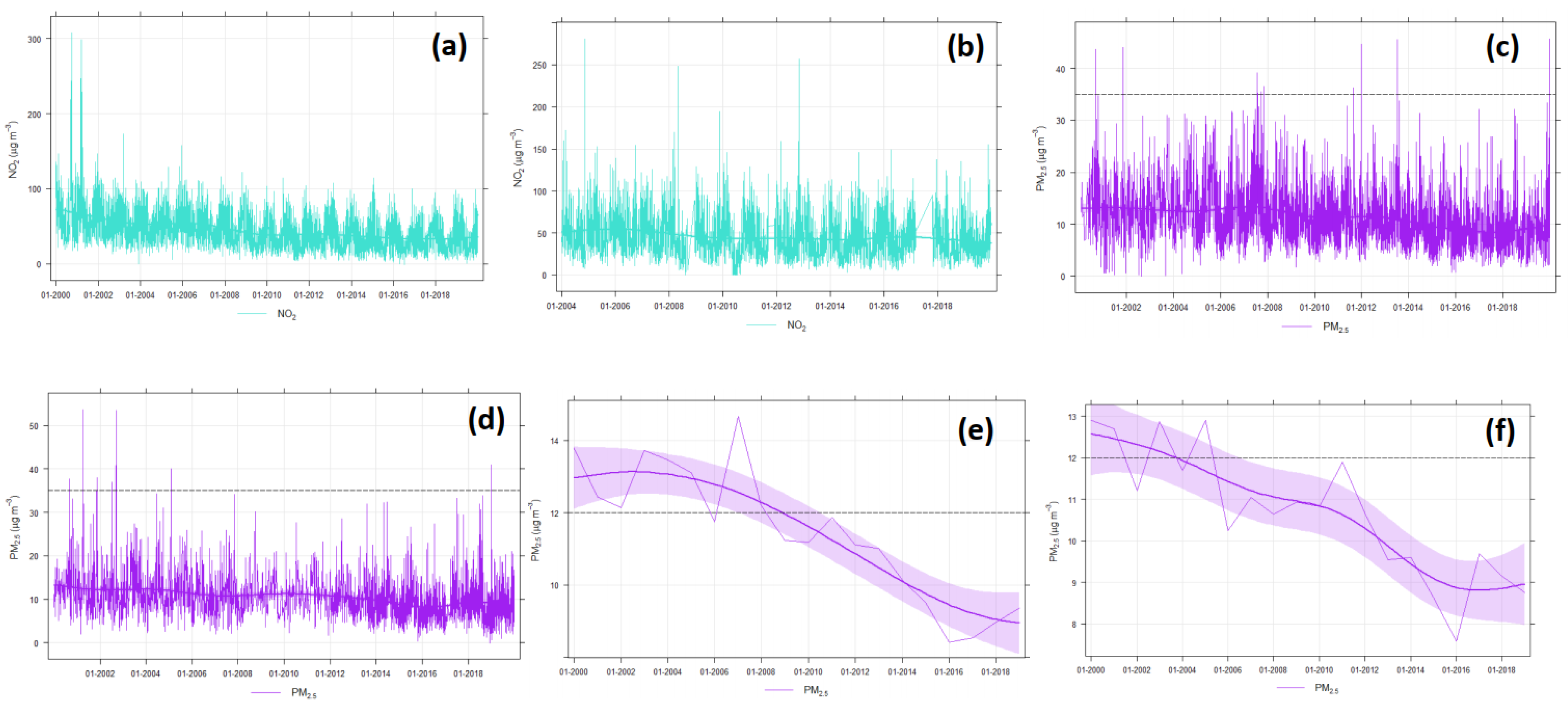
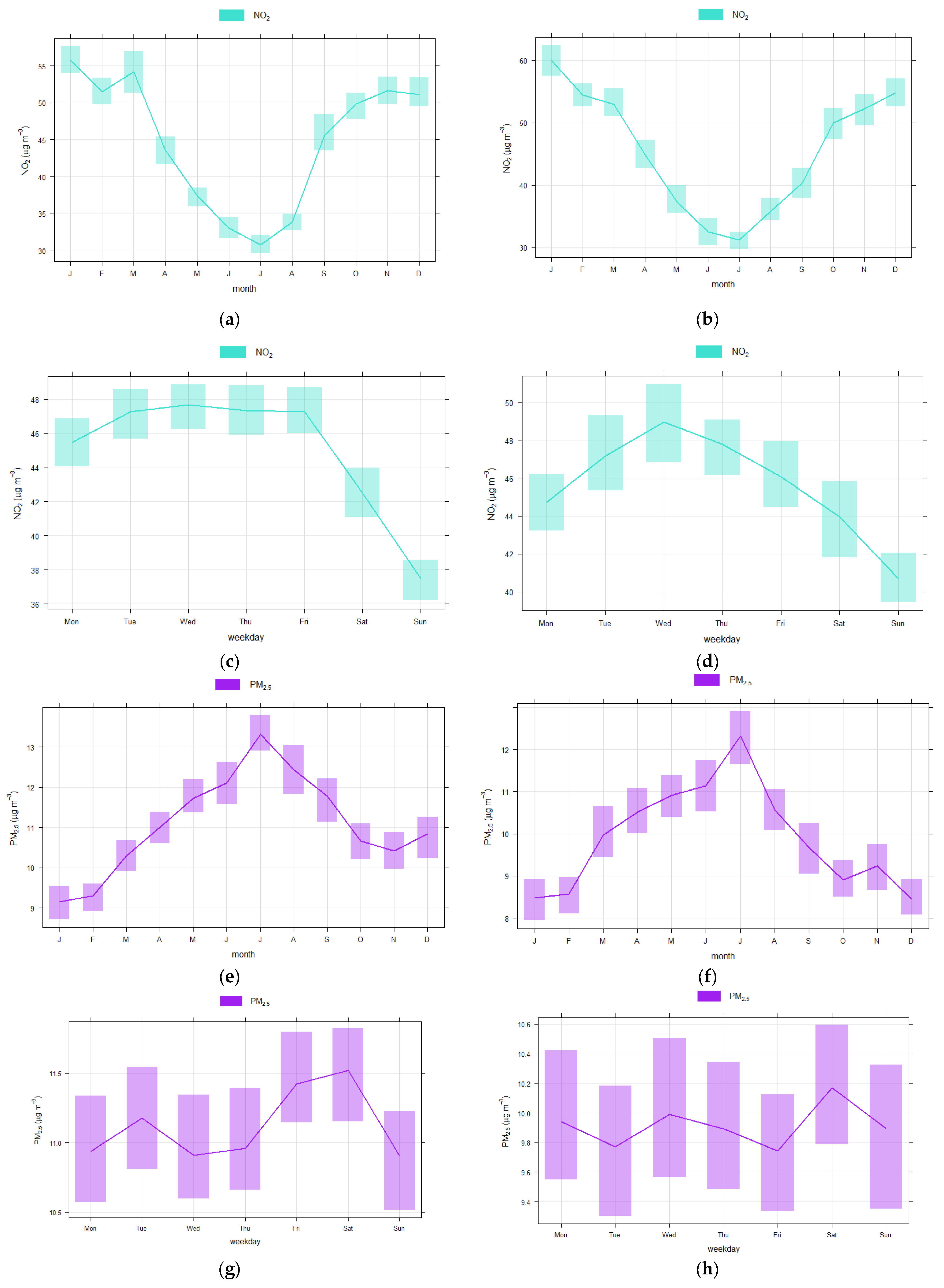
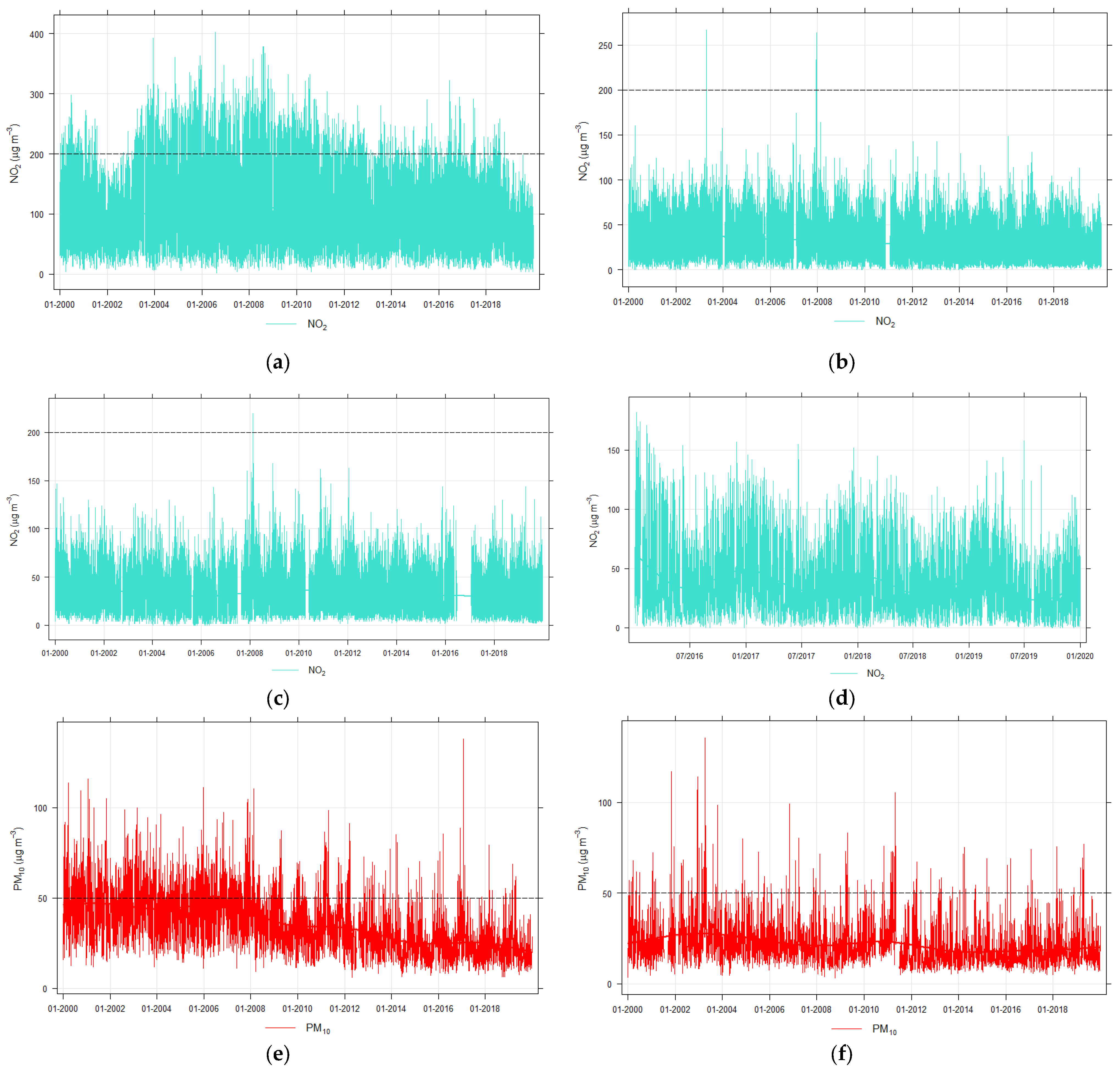
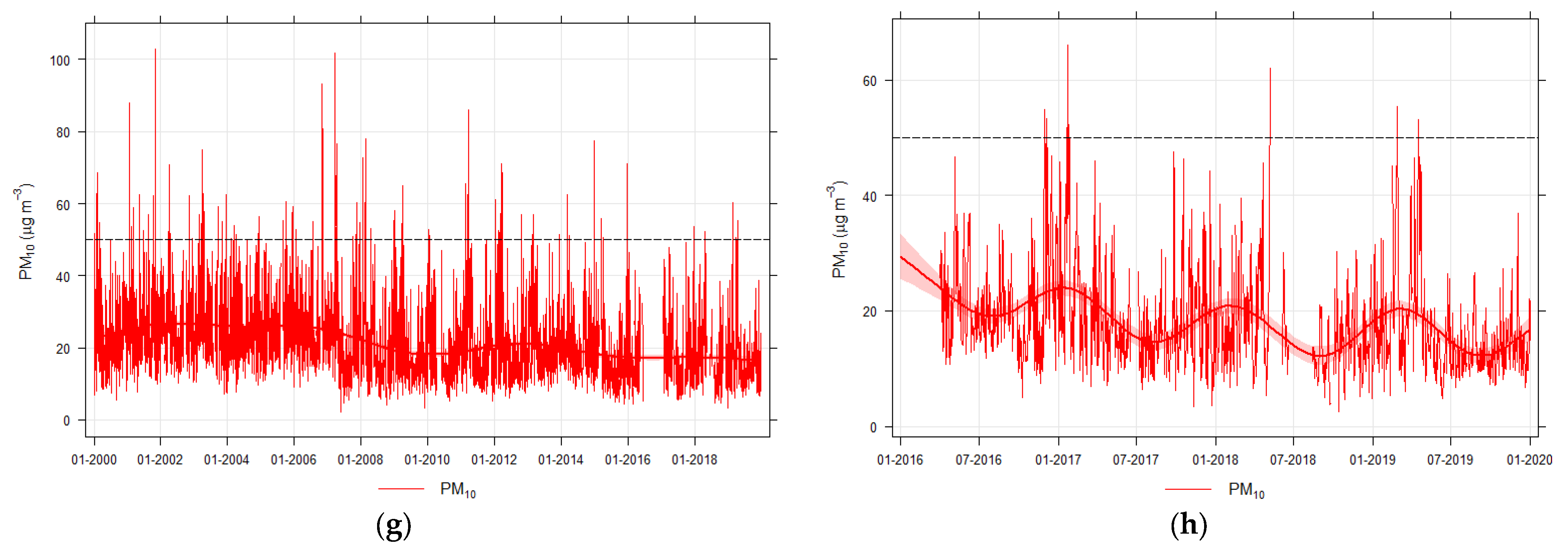
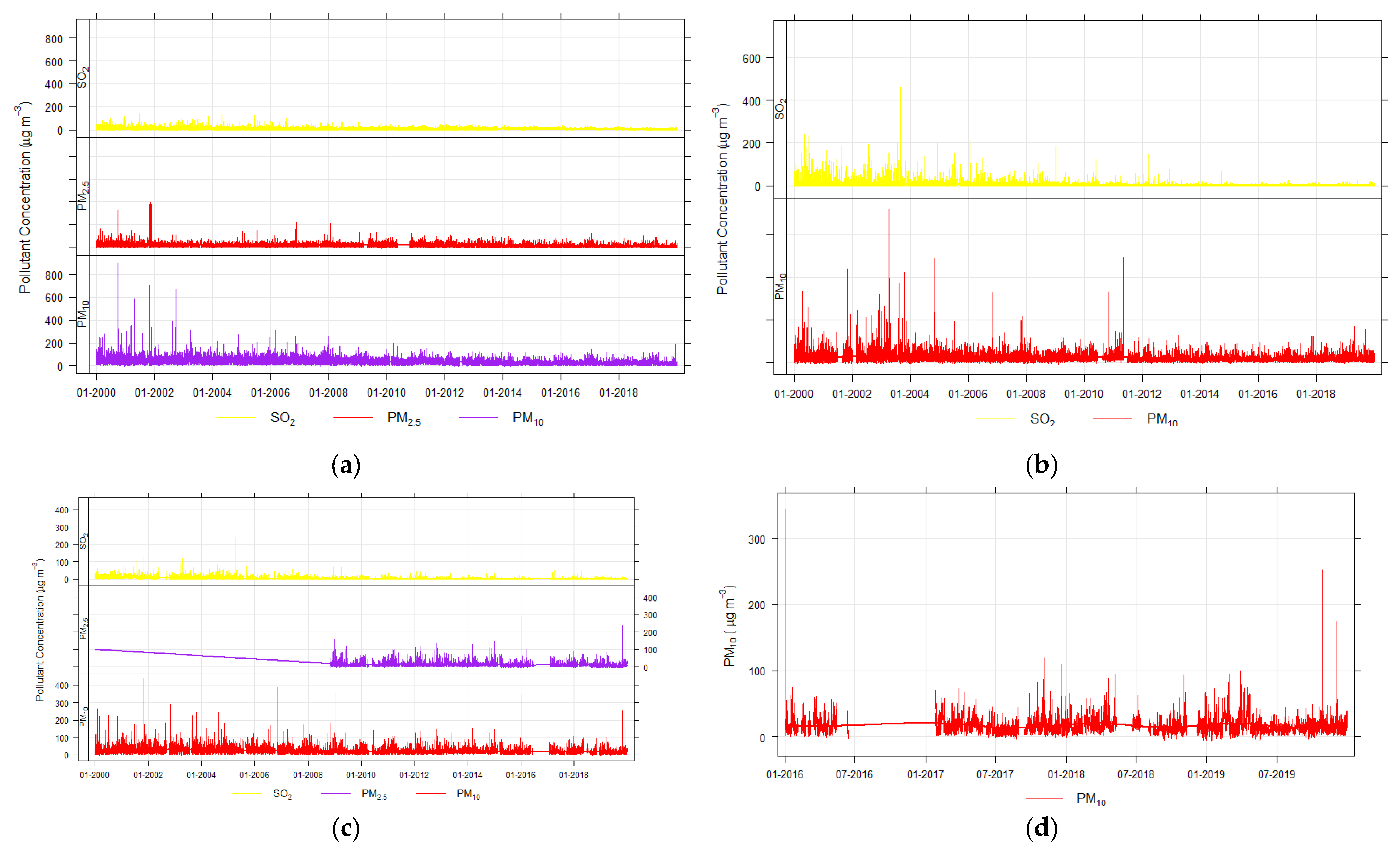
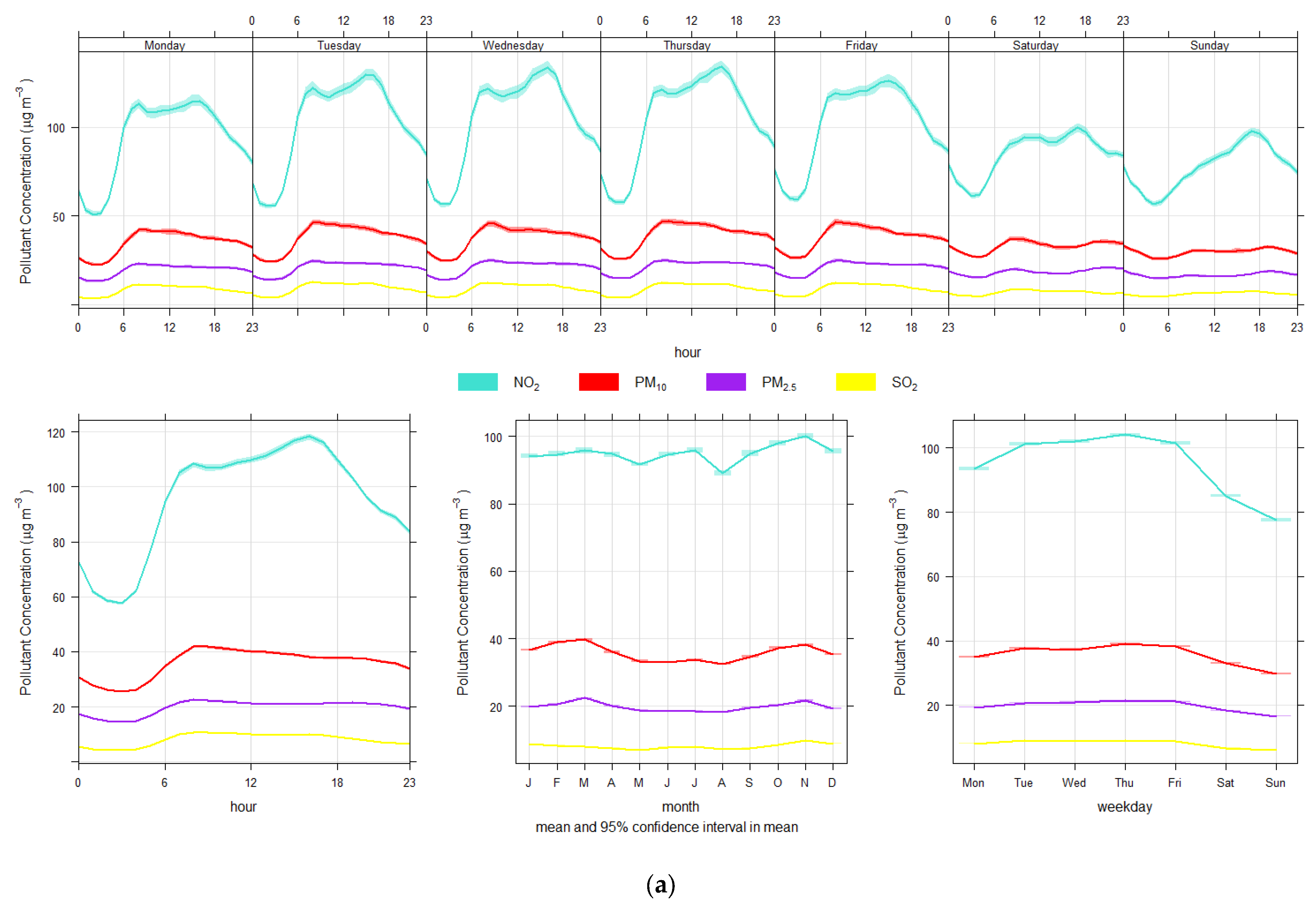
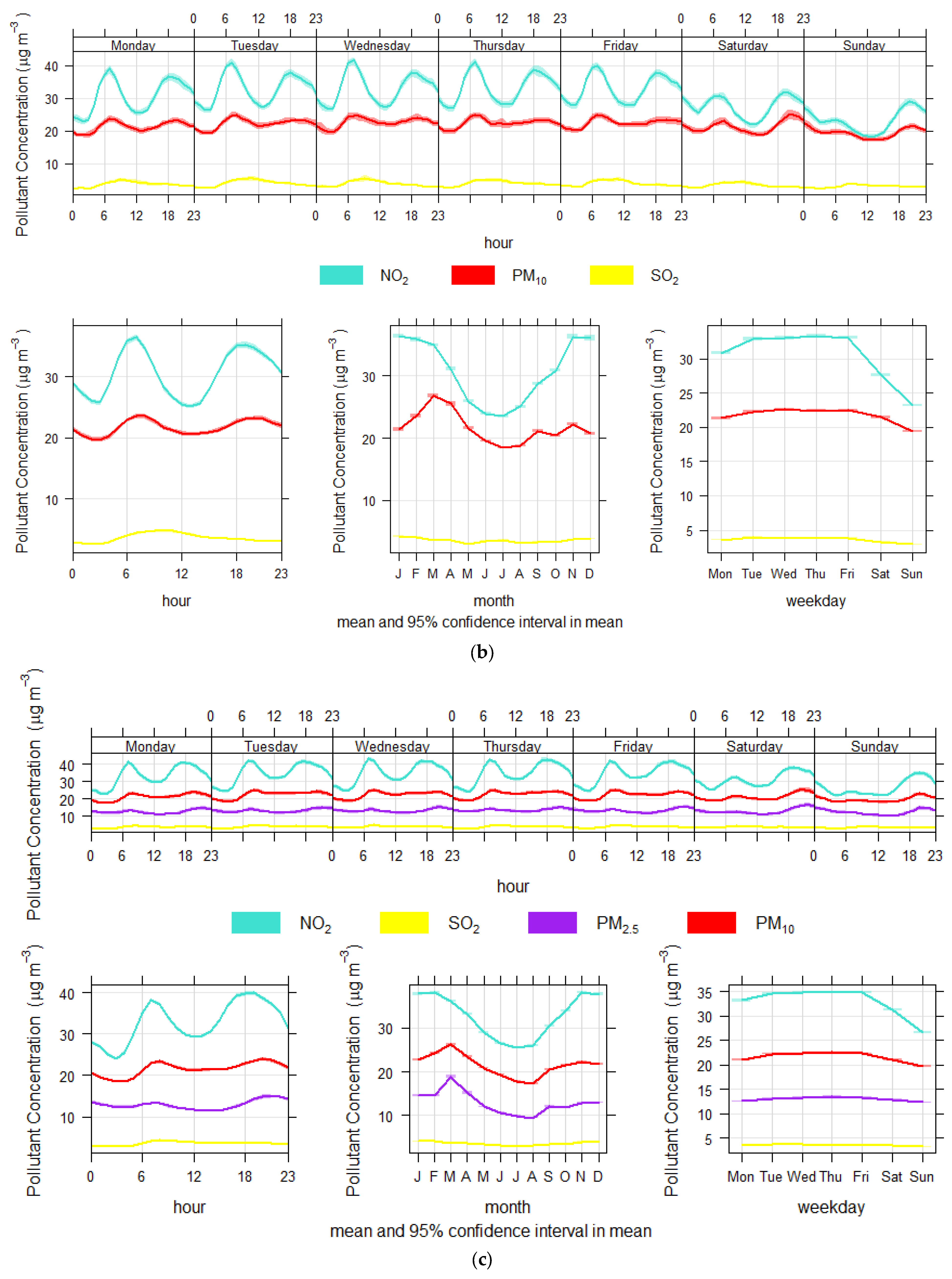


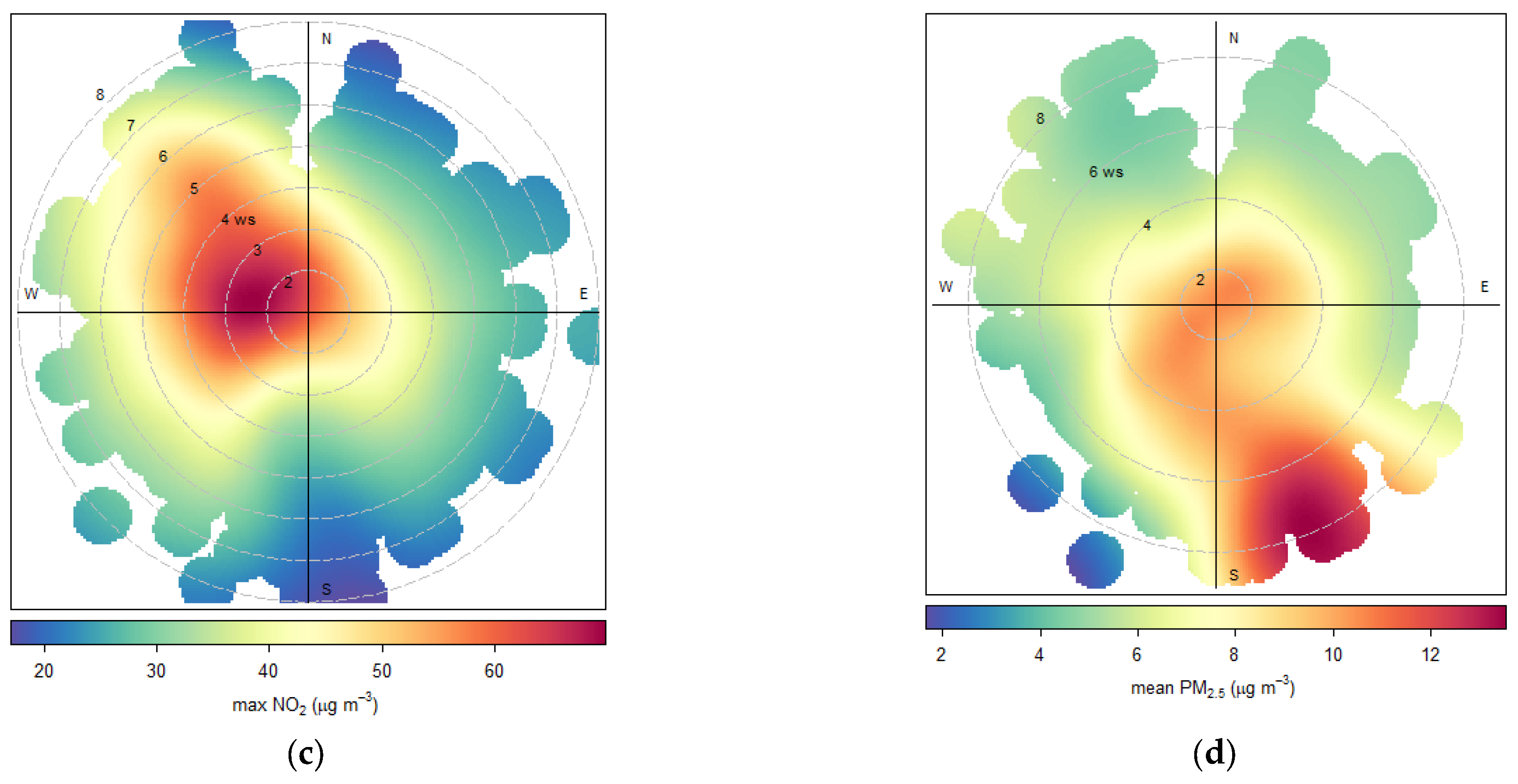
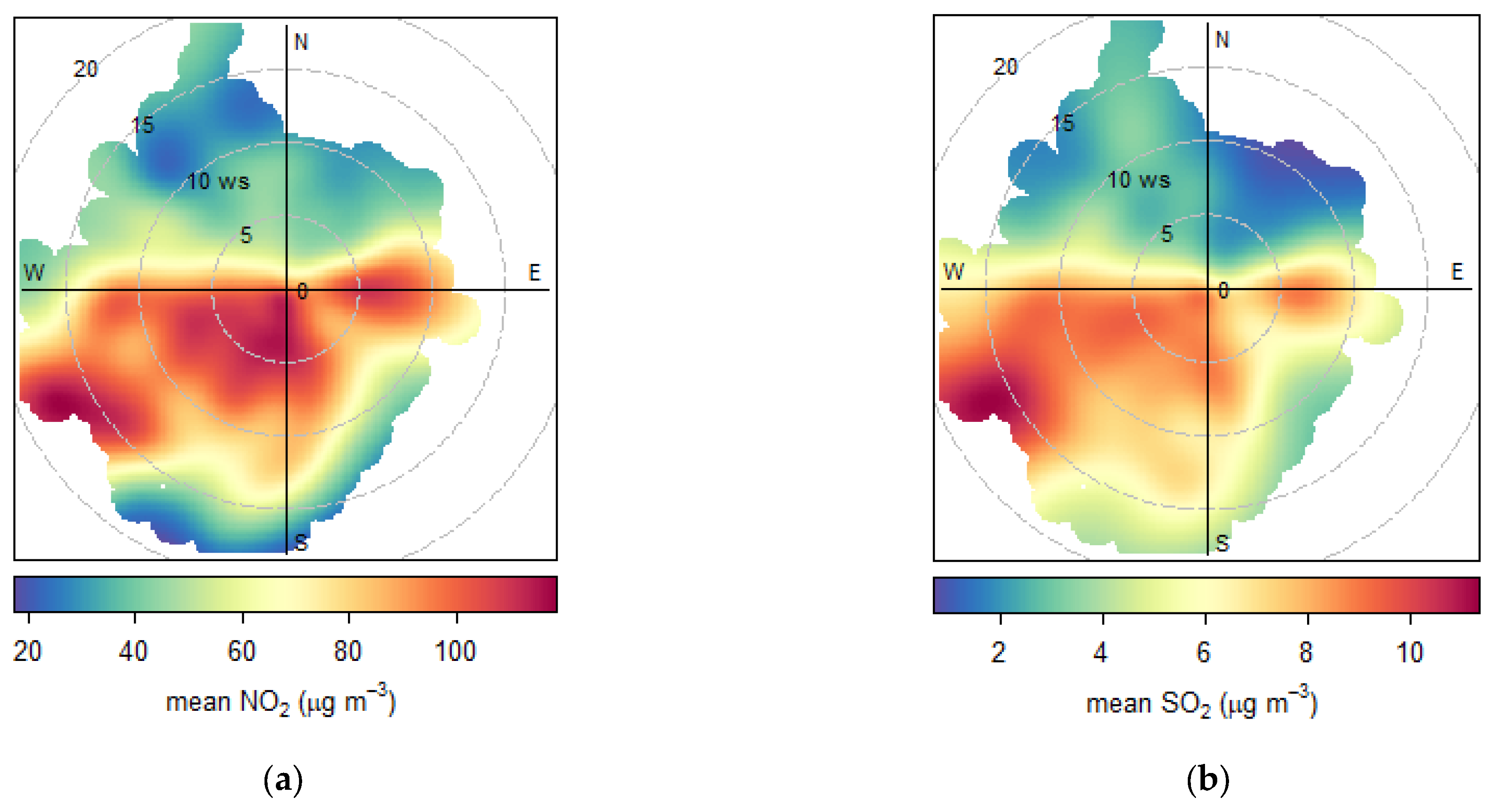
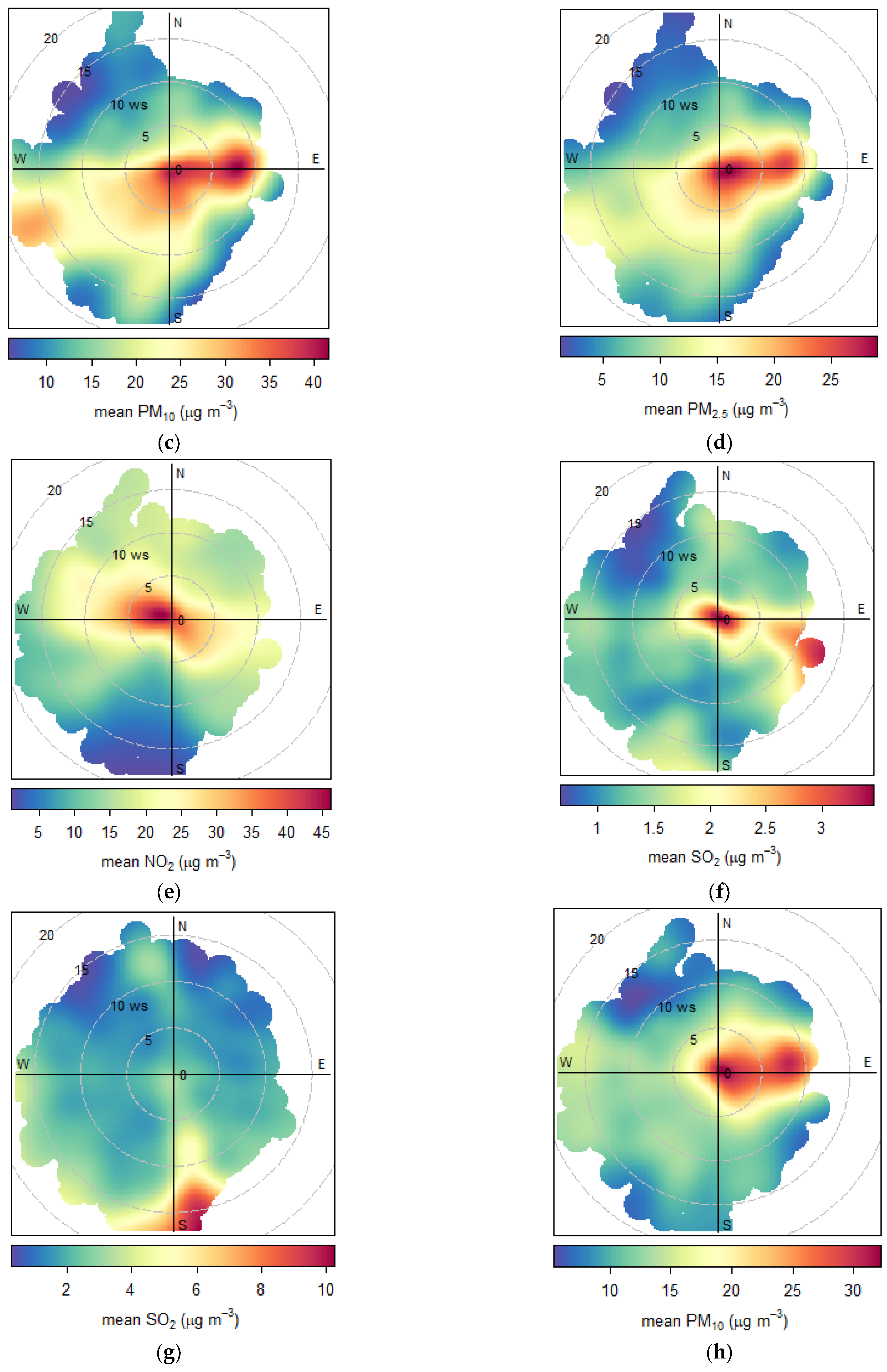

References
- Gobbi, G.P.; Liberto, L.D.; Barnaba, F. Impact of ports emissions on EU-regulated and non-regulated air quality indicators: The case of Civitavecchia (Italy). Sci. Total Environ. 2020, 719, 134984. [Google Scholar] [CrossRef] [PubMed]
- Adomaitis, K. World’s Major Port Cities Are Growing Faster Than Inland Cities. 2014. Available online: https://blog.euromonitor.com/worlds-major-port-cities-are-growing-faster-than-inland-cities/ (accessed on 5 February 2021).
- Yu, L.; Xu, P.; Shi, J.; Chen, J.; Zhen, H. Driving Mechanism of Port-City Spatial Relation Evolution from an Ecological Perspective: Case Study of Xiamen Port of China. Sustainability 2020, 12, 2857. [Google Scholar] [CrossRef] [Green Version]
- Dwarakwih, G.S.; Salim, M. A Review on the role of ports in the development of ports. Aquat. Procedia 2015, 4, 295–301. [Google Scholar] [CrossRef]
- Roberts, T.; Williams, I.; Preston, J. The Southampton system: A new universal standard approach for port-city classification. Marit. Policy Manag. 2021, 48, 530–542. [Google Scholar] [CrossRef]
- Santos, A.M.P.; Salvador, R.; Dias, J.C.Q.; Soares, C.G. Assessment of port economic impacts on regional economy with a case study on the Port of Lisbon. Marit. Policy Manag. 2018, 45, 684–698. [Google Scholar] [CrossRef]
- Gupta, A.K.; Gupta, S.K.; Patil, R.S. Environmental management plan for ship for port and harbour projects. Clean Technol. Environ. Policy 2005, 7, 133–141. [Google Scholar] [CrossRef]
- Roberts, T.; Williams, I.; Preston, J.; Clarke, N.; Odum, M.; O’Gorman, S. A Virtuous Circle? Increasing Local Benefits from Ports by Adopting Circular Economy Principles. Sustainability 2021, 13, 7079. [Google Scholar] [CrossRef]
- Von Schneidemesser, E.; Steinmar, K.; Weatherhead, E.C.; Bonn, B.; Gerwig, H.; Quedenau, J. Air pollution at human scales in an urban environment: Impact of local environment and Traffics on particle number concentrations. Sci. Total Environ. 2019, 688, 691–700. [Google Scholar] [CrossRef]
- Langella, G.; Iodice, P.; Amoresano, A.; Senatore, A. Ship engines and air pollutants: Emission during fuel change-over and dispersion over coastal areas. Int. J. Energy Environ. Eng. 2016, 7, 307–330. [Google Scholar] [CrossRef] [Green Version]
- Wan, Y.; Zhang, A. Urban Road Congestion and Seaport Competition. J. Transp. Econ. Policy 2013, 47, 55–70. [Google Scholar]
- Zhang, K.; Batterman, S. Air pollution and health risks due to vehicle traffic. Sci. Total Environ. 2013, 405–451, 307–316. [Google Scholar] [CrossRef] [PubMed] [Green Version]
- Viana, M.; Hammingh, P.; Colette, A.; Querrol, X.; Degraeuwe, B.; de Vlieger, I.; van Aardenne, J. Impact of maritime transport emissions on coastal air quality in Europe. Atmos. Environ. 2014, 90, 96–105. [Google Scholar] [CrossRef]
- Mueller, D.; Uibel, S.; Takemura, M.; Klingelhoefer, D.; Groneberg, D.A. Ships, ports and particulate air pollution—An analysis of recent studies. J. Occup. Med. Toxicol. 2011, 6, 31. [Google Scholar] [CrossRef] [PubMed] [Green Version]
- Apte, K.; Salvi, S. Household air pollution and its effects on health. F1000Reseacrh 2016, 28, 5. [Google Scholar] [CrossRef] [PubMed]
- Platt, S.M.; El Haddad, I.; Pieber, S.M.; Zardini, A.A.; Suarez-Bertoa, E.; Clairotte, M.; Dallenbach, K.R.; Huang, R.J.; Slowik, J.G.; Hellebust, S.; et al. Gasoline cars produce more carbonaceous particulate matter than modern filter-equipped diesel cars. Sci. Rep. 2017, 7, 4928. [Google Scholar] [CrossRef] [PubMed] [Green Version]
- Endres, S.; Maes, F.; Hopkins, F.; Houghton, K.; Mårtensson, E.M.; Oeffner, J.; Quack, B.; Singh, P.; Turner, D.A. New Perspective at the Ship-Air-Sea-Interface: The Environmental Impacts of Exhaust Gas Scrubber Discharge. Front. Mar. Sci. 2018, 5, 139. [Google Scholar] [CrossRef] [Green Version]
- Air Quality Expert Group (AQEG). Non-Exhaust Emissions from Road Traffic; Defra: London, UK, 2019.
- European Environmental Agency (EEA). Industrial Pollution in Europe. 2021. Available online: https://www.eea.europa.eu/data-and-maps/indicators/industrial-pollution-in-europe-3/assessment (accessed on 6 February 2021).
- Kelly, F.J.; Fussell, J.C. Air pollution and public health: Emerging hazards and improved understanding of risk. Environ. Geochem. Health 2015, 37, 631–649. [Google Scholar] [CrossRef] [Green Version]
- World Health Organization (WHO) Air Pollution. 2021. Available online: https://www.who.int/health-topics/air-pollution#tab=tab_2 (accessed on 6 February 2021).
- Sanderfoot, O.V.; Holloway, T. Air pollution impacts on avian species via inhalation exposure and associated outcomes. Environ. Res. Lett. 2017, 12, 083002. [Google Scholar] [CrossRef]
- Manisaldis, I.; Stravropolous, E.; Stravropoulos, A.; Bezitrzologu, E. Environmental and Health Impacts of Air Pollution: A Review. Front. Public Health 2020, 8, 14. [Google Scholar] [CrossRef] [Green Version]
- United Nations, Department of Economic and Social Affairs. Population Division 2019. In World Population Prospects 2019: Highlights (ST/ESA/SER.A/423); United Nations Department of Economic and Social Affairs: New York, NY, USA, 2019. [Google Scholar]
- Crichton, S.; Barratt, B.; Spiridou, A.; Hoang, U.; Fen Liang, S.; Kovalchuck, Y.; Beevers, S.D.; Kelly, F.J.; Delaney, B.; Wolfe, C.D.A. Associations between exhaust and non-exhaust particulate matter and stroke incidence by stroke subtype in South London. Sci. Total Environ. 2016, 568, 278–284. [Google Scholar] [CrossRef] [Green Version]
- City of Houston. About Houston. 2021. Available online: https://www.houstontx.gov/abouthouston/houstonfacts.html (accessed on 13 April 2021).
- City of Houston. About Houston: Business Overview. 2021. Available online: https://www.houstontx.gov/abouthouston/business.html (accessed on 13 April 2021).
- Port of Houston. About Us. 2021. Available online: https://porthouston.com/about-us/ (accessed on 13 April 2021).
- East Aldine Management District. About. 2021. Available online: https://aldinedistrict.org/about/ (accessed on 13 April 2021).
- Harris County. Community Plans: Aldine Community Plan. 2021. Available online: https://csd.harriscountytx.gov/Pages/Aldine.aspx (accessed on 13 April 2021).
- Capobianco, T.; Hilderbrand, S.M.; Honeycutt, M.; Lee, J.S.; McCant, D.; Grant, R.L. Impact of three interactive Texas state regulatory programs to decrease ambient air toxic levels. J. Air Waste Manag. Assoc. 2013, 63, 507–520. [Google Scholar] [CrossRef] [PubMed] [Green Version]
- Statista 2021, Population of Largest Urban Areas in the United Kingdom (UK) 2019. Available online: https://www.statista.com/statistics/294645/population-of-selected-cities-in-united-kingdom-uk/ (accessed on 17 April 2021).
- European Commission. Internal Market, Industry, Entrepreneurship and SMEs: London. 2021. Available online: https://ec.europa.eu/growth/tools-databases/regional-innovation-monitor/base-profile/london (accessed on 17 April 2021).
- Port of London Authority. Port of London Economic Impact Study. 2020. Available online: http://www.pla.co.uk/About-Us/Port-of-London-Economic-Impact-Study#:~:text=This%20study%20estimates%20that%20the,on%20the%20London%20port%20sector. (accessed on 17 April 2021).
- Port of London Authority. Fact File. 2021. Available online: http://www.pla.co.uk/About-Us/Fact-File#:~:text=The%20Port%20of%20London%3A,to%20Teddington%2C%20some%20150%20kilometres (accessed on 17 April 2021).
- Harrison, R.M.; Jones, A.M.; Gietl, J.; Yin, J.; Green, D.C. Estimation of Contributions of Brake Dust, Tire Wear, and Resuspension to Non-Exhaust Traffic Particles Derived from Atmospheric Measurements. Environ. Sci. Technol. 2012, 46, 6523–6529. [Google Scholar] [CrossRef]
- Jeanjean, A.P.R.; Buccolieri, R.; Eddy, J.; Monks, P.S.; Leigh, R.J. Air quality affected by trees in real street canyons: The case of Marylebone neighbourhood in central London. Urban For. Urban Green. 2017, 22, 41–53. [Google Scholar] [CrossRef]
- Department for Environment, Food & Rural Affairs (Defra). Site Information for Thurrock(UKA00272). 2021. Available online: https://uk-air.defra.gov.uk/networks/site-info?site_id=THUR (accessed on 17 April 2021).
- Department for Environment, Food & Rural Affairs (Defra). Site Information for London Marylebone Road(UKA00315). 2021. Available online: https://uk-air.defra.gov.uk/networks/site-info?site_id=MY1 (accessed on 17 April 2021).
- Southampton Data Observatory. Population Size and Structure. 2019. Available online: https://data.southampton.gov.uk/population/pop-structure/ (accessed on 18 April 2021).
- McLaren, J.; Williams, I.D. The impact of communicating information about air pollution events on public health. Sci. Total Environ. 2015, 538, 478–491. [Google Scholar] [CrossRef]
- Associated British Ports (APB). About ABP: Economic Impact. 2021. Available online: https://www.abports.co.uk/about-abp/economic-impact/#:~:text=Together%20with%20our%20customers%2C%20our,119%2C000%20jobs%20across%20the%20country.&text=The%20Port%20of%20Southampton%20is,for%20UK%20manufacturers%20every%20year (accessed on 18 April 2021).
- Associated British Ports (APB). Port of Southampton: Port Master Plan 2016–2035 CONSULTATION DRAFT. 2021. Available online: https://www.southamptonvts.co.uk//admin/content/files/New%20capital%20projects/Master%20Plan%202016/Master%20Plan%202016%20-%202035%20Consultation%20Document%20Oct%202016.pdf (accessed on 19 April 2021).
- Southampton City Council. Eastern Access to Southampton A3024 Bursledon Road Junctions: Southampton City Council bid to DfT National Productivity Investment Fund. 2017. Available online: https://www.southampton.gov.uk/policies/southampton-city-council-eastern-access-to-southampton-a3024-npif-application-form-final_tcm63-429002.pdf (accessed on 19 April 2021).
- Department for Environment, Food & Rural Affairs (Defra). Site Information for Southampton Centre(UKA00235). 2021. Available online: https://uk-air.defra.gov.uk/networks/site-info?site_id=SOUT (accessed on 19 April 2021).
- Department for Environment, Food & Rural Affairs (Defra). Site Information for Southampton A33(UKA00613). 2021. Available online: https://uk-air.defra.gov.uk/networks/site-info?site_id=SA33 (accessed on 19 April 2021).
- United States Environmental Protection Agency (EPA). Outdoor Air Quality Data: Download Daily Data. 2021. Available online: https://www.epa.gov/outdoor-air-quality-data/download-daily-data (accessed on 19 April 2021).
- Department for Environment, Food & Rural Affairs (Defra). Data Archive: Data Selector. 2021. Available online: http://uk-air.defra.gov.uk/data/data_selector (accessed on 8 May 2021).
- Carslaw, D.C. The Openair Manual—Open-Source Tools for Analysing Air Pollution Data; Manual for Version 2.6-6; University of York: Heslington, UK, 2019. [Google Scholar]
- World Weather Online. Historical Weather Data. 2021. Available online: https://www.worldweatheronline.com/hwd/ (accessed on 19 April 2021).
- National Centres For Environmental Information (NOAA). Data Tools: Find a Station. 2021. Available online: https://www.ncdc.noaa.gov/cdo-web/datatools/findstation (accessed on 22 April 2021).
- Fly2Houston. Our Story: Our Airports. 2021. Available online: https://www.fly2houston.com/biz/about (accessed on 22 April 2021).
- Department for Transport. Road Traffic Bulk Downloads. 2021. Available online: https://roadtraffic.dft.gov.uk/downloads (accessed on 19 April 2021).
- United States Environmental Protection Agency (EPA). NAAQS Table. 2021. Available online: https://www.epa.gov/criteria-air-pollutants/naaqs-table (accessed on 13 February 2021).
- Air Pollution Information System (APIS). Unit Conversion. 2021. Available online: http://www.apis.ac.uk/unit-conversion (accessed on 22 April 2021).
- SensorsONE. inHg to mbar Conversion Table. 2021. Available online: https://www.sensorsone.com/inhg-to-mbar-conversion-table/ (accessed on 22 April 2021).
- Environment Agency. Technical Guidance Note (Monitoring) M8 Monitoring Ambient Air Environment Agency Version 2 May 2011. 2011. Available online: https://assets.publishing.service.gov.uk/government/uploads/system/uploads/attachment_data/file/301188/TGN_M8_Monitoring_Ambient_Air.pdf (accessed on 7 April 2021).
- Department for Environment, Food & Rural Affairs (Defra). UK and EU Air Quality Limits. 2021. Available online: https://uk-air.defra.gov.uk/air-pollution/uk-eu-limits (accessed on 8 May 2021).
- Sexton, K.; Linder, S.H. Houston’s Novel Strategy to Control Hazardous Air Pollutants: A Case Study in Policy Innovation and Political Stalemate. Environ. Health Insights 2015, 9, EHI-S15670. [Google Scholar] [CrossRef] [PubMed]
- Li, L.; Talbot, R.; Lan, X. Influence of Climate Change and Meteorological Factors on Houston’s Air Pollution: Ozone a Case Study. Atmosphere 2015, 6, 623–640. [Google Scholar] [CrossRef] [Green Version]
- Sexton, K.; Linder, S.H.; Marko Bethel, H.; Lupo, P.J. Comparative Assessment of Air Pollution–Related Health Risks in Houston. Environ. Health Perspect. 2007, 115, 1388–1393. [Google Scholar] [CrossRef]
- Khaniabadi, Y.O.; Goudarzi, G.; Daryanoosh, S.M.; Borgini, A.; Tittarelli, A.; De Marco, A. Exposure to PM10, NO2, and O3 and impacts on human health. Environ. Sci. Pollut. Res. 2017, 24, 2781–2789. [Google Scholar] [CrossRef]
- Texas Commission on Environmental Quality. Site List. 2021. Available online: https://www17.tceq.texas.gov/tamis/index.cfm?fuseaction=report.site_list (accessed on 13 May 2021).
- Port of Houston. Container Terminals. 2021. Available online: https://porthouston.com/container-terminals/ (accessed on 13 May 2021).
- Xu, Y.; Xue, W.; Lei, Y.; Zhao, Y.; Cheng, S.; Zhenhai, R.; Huang, Q. Impact of Meteorological Conditions on PM2.5 Pollution in China during Winter. Atmosphere 2016, 9, 429. [Google Scholar] [CrossRef] [Green Version]
- Air Quality Expert Group (AQEG). Fine Particulate Matter (PM2.5) in the UK; Defra: London, UK, 2012.
- Requia, W.J.; Jhnu, I.; Coull, B.A.; Koutrakis, P. Climate impact on ambient PM2.5 elemental concentration in the United States: A trend analysis over the last 30 years. Environ. Int. 2019, 131, 104888. [Google Scholar] [CrossRef]
- Bathmanabhan, S.; Madanayak, S.N.S. Analysis and interpretation of particulate matter—PM10, PM2.5 and PM1 emissions from the heterogeneous traffic near an urban roadway. Atmos. Pollut. Res. 2010, 1, 184–194. [Google Scholar]
- Alnawaiseh, N.A.; Hashim, J.H.; Isa, Z.M. Relationship Between Vehicle Count and Particulate Air Pollution in Amman, Jordan. Asia-Pac. J. Public Health 2015, 27, 1742–1751. [Google Scholar] [CrossRef]
- Rossi, R.; Ceccato, R.; Gastaldi, M. Effect of Road Traffic on Air Pollution. Experimental Evidence from COVID-19 Lockdown. Sustainability 2020, 12, 8984. [Google Scholar] [CrossRef]
- Vardoulakis, S.; Fischer, B.E.A.; Pericleous, K.; Gonzalez-Flesca, N. Modelling air quality in street canyons: A review. Atmos. Environ. 2003, 37, 155–182. [Google Scholar] [CrossRef] [Green Version]
- Harrison, R.M.; Jones, A.M. Multisite Study of Particulate Number Concentrations in Urban Air. Environ. Sci. Technol. 2005, 39, 6063–6070. [Google Scholar] [CrossRef]
- Hill, D. ‘Filthy Glamour’: Could Polluted Marylebone Road Help Fix London’s Air? 2017. Available online: https://www.theguardian.com/cities/2017/feb/15/marylebone-road-london-air-pollution-crisis-sadiq-khan (accessed on 13 April 2021).
- Hicks, W.; Beevers, S.; Tremper, A.; Stewart, G.; Priestman, M.; Kelly, F.J.; Lanoisellé, M.; Lowry, D.; Green, D.C. Quantification of Non-Exhaust Particulate Matter Traffic Emissions and the Impact of COVID-19 Lockdown at London Marylebone Road. Atmosphere 2021, 12, 190. [Google Scholar] [CrossRef]
- Grange, S.K.; Lewis, A.C.; Carslaw, D.C. Source apportionment advances using polar plots of bivariate correlation and regression statistics. Atmos. Environ. 2016, 145, 128–134. [Google Scholar] [CrossRef]
- Grange, S.K.; Carslaw, D.C. Using meteorological normalisation to detect interventions in air quality time series. Sci. Total Environ. 2019, 653, 578–588. [Google Scholar] [CrossRef]
- Latha, K.M.; Highwood, E.J. Studies on particulate matter (PM10) and its precursors over urban environment of Reading, UK. J. Quant. Spectrosc. Radiat. Transf. 2006, 101, 367–379. [Google Scholar] [CrossRef]
- Bigi, A.; Harrison, R.M. Analysis of the air pollution climate at a central urban background site. Atmos. Environ. 2010, 44, 2004–2012. [Google Scholar] [CrossRef]
- Bulot, F.M.J.; Johnston, S.J.; Basford, P.J.; Easton, N.H.C.; Apetroaie-Cristea, A.; Foster, G.L.; Morris, A.K.R.; Cox, S.J.; Loxham, M. Long-term field comparison of multiple low-cost particulate matter sensors in an outdoor urban environment. Sci. Rep. 2019, 9, 7497. [Google Scholar] [CrossRef] [PubMed] [Green Version]
- Samuele, M.; Elia, B.; Bianca, R. Sustainability of logistics infrastructures: Operational and technological alternatives to reduce the impact on air quality. In XXVI Summer School “Francesco Turco”—Industrial Systems Engineering; University of Bergamo: Bergamo, Italy, 2021. [Google Scholar]
| Source | Pollutants |
|---|---|
| Road Traffic: From the combustion of diesel and petrol in engines, released into the atmosphere via vehicular exhaust. | Carbonaceous particulate matter (PM) including Black Carbon, Volatile Organic Compounds (VOCs), Primary Organic Aerosols. Inorganic compounds: trace Nitrogen Oxides (NOx), Ammonia and Sulphur dioxide (SO2) |
| Road Traffic (Non-exhaust): Including brake wear, tyre, road surface wear and resuspended road dust. | PM10 and PM2.5 |
| Marine Traffic including shipping and cruise ships: From combustion of low-grade fuel that is rich in sulphur, which occurs in ship engines. | Nitrogen oxide (NOx) including NO and NO2. Sulphur Oxides (SOx) including SO2 and SO3. PM including organic carbon, black carbon, polycyclic hydrocarbons (PAH) and heavy metals |
| Residential: Combustion of fuel for heating and cooking. | SOx, PM, NOx, heavy metals, VOCs, and PAHs |
| Industrial | SOx, PM, NOx, heavy metals, and non-methane volatile organic compounds |
Disclaimer/Publisher’s Note: The statements, opinions and data contained in all publications are solely those of the individual author(s) and contributor(s) and not of MDPI and/or the editor(s). MDPI and/or the editor(s) disclaim responsibility for any injury to people or property resulting from any ideas, methods, instructions or products referred to in the content. |
© 2023 by the authors. Licensee MDPI, Basel, Switzerland. This article is an open access article distributed under the terms and conditions of the Creative Commons Attribution (CC BY) license (https://creativecommons.org/licenses/by/4.0/).
Share and Cite
Owusu-Mfum, S.; Hudson, M.D.; Osborne, P.E.; Roberts, T.J.; Zapata-Restrepo, L.M.; Williams, I.D. Atmospheric Pollution in Port Cities. Atmosphere 2023, 14, 1135. https://doi.org/10.3390/atmos14071135
Owusu-Mfum S, Hudson MD, Osborne PE, Roberts TJ, Zapata-Restrepo LM, Williams ID. Atmospheric Pollution in Port Cities. Atmosphere. 2023; 14(7):1135. https://doi.org/10.3390/atmos14071135
Chicago/Turabian StyleOwusu-Mfum, Shnelle, Malcolm D. Hudson, Patrick E. Osborne, Toby J. Roberts, Lina M. Zapata-Restrepo, and Ian D. Williams. 2023. "Atmospheric Pollution in Port Cities" Atmosphere 14, no. 7: 1135. https://doi.org/10.3390/atmos14071135





